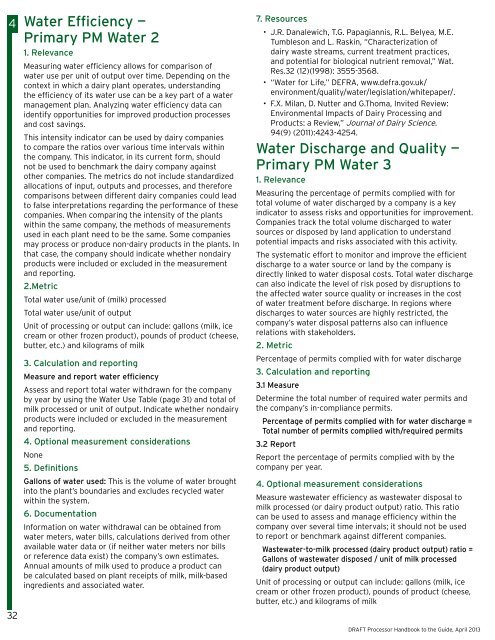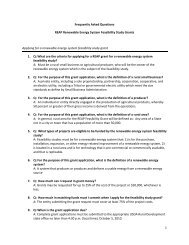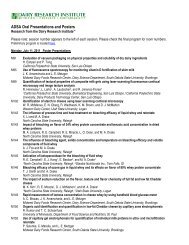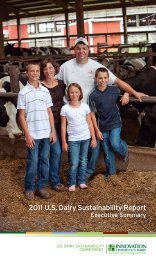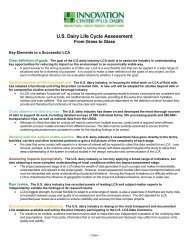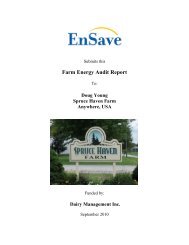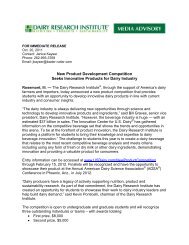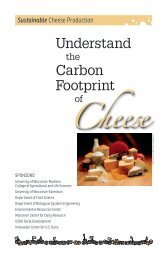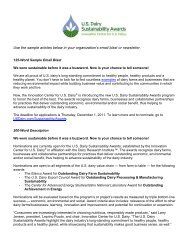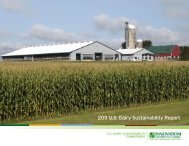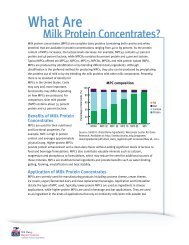Processor Handbook - Innovation Center for US Dairy
Processor Handbook - Innovation Center for US Dairy
Processor Handbook - Innovation Center for US Dairy
Create successful ePaper yourself
Turn your PDF publications into a flip-book with our unique Google optimized e-Paper software.
4 Water Efficiency —<br />
Primary PM Water 2<br />
1. Relevance<br />
32<br />
Measuring water efficiency allows <strong>for</strong> comparison of<br />
water use per unit of output over time. Depending on the<br />
context in which a dairy plant operates, understanding<br />
the efficiency of its water use can be a key part of a water<br />
management plan. Analyzing water efficiency data can<br />
identify opportunities <strong>for</strong> improved production processes<br />
and cost savings.<br />
This intensity indicator can be used by dairy companies<br />
to compare the ratios over various time intervals within<br />
the company. This indicator, in its current <strong>for</strong>m, should<br />
not be used to benchmark the dairy company against<br />
other companies. The metrics do not include standardized<br />
allocations of input, outputs and processes, and there<strong>for</strong>e<br />
comparisons between different dairy companies could lead<br />
to false interpretations regarding the per<strong>for</strong>mance of these<br />
companies. When comparing the intensity of the plants<br />
within the same company, the methods of measurements<br />
used in each plant need to be the same. Some companies<br />
may process or produce non-dairy products in the plants. In<br />
that case, the company should indicate whether nondairy<br />
products were included or excluded in the measurement<br />
and reporting.<br />
2.Metric<br />
Total water use/unit of (milk) processed<br />
Total water use/unit of output<br />
Unit of processing or output can include: gallons (milk, ice<br />
cream or other frozen product), pounds of product (cheese,<br />
butter, etc.) and kilograms of milk<br />
3. Calculation and reporting<br />
Measure and report water efficiency<br />
Assess and report total water withdrawn <strong>for</strong> the company<br />
by year by using the Water Use Table (page 31) and total of<br />
milk processed or unit of output. Indicate whether nondairy<br />
products were included or excluded in the measurement<br />
and reporting.<br />
4. Optional measurement considerations<br />
None<br />
5. Definitions<br />
Gallons of water used: This is the volume of water brought<br />
into the plant’s boundaries and excludes recycled water<br />
within the system.<br />
6. Documentation<br />
In<strong>for</strong>mation on water withdrawal can be obtained from<br />
water meters, water bills, calculations derived from other<br />
available water data or (if neither water meters nor bills<br />
or reference data exist) the company’s own estimates.<br />
Annual amounts of milk used to produce a product can<br />
be calculated based on plant receipts of milk, milk-based<br />
ingredients and associated water.<br />
7. Resources<br />
• J.R. Danalewich, T.G. Papagiannis, R.L. Belyea, M.E.<br />
Tumbleson and L. Raskin, “Characterization of<br />
dairy waste streams, current treatment practices,<br />
and potential <strong>for</strong> biological nutrient removal,” Wat.<br />
Res.32 (12)(1998): 3555-3568.<br />
• “Water <strong>for</strong> Life,” DEFRA, www.defra.gov.uk/<br />
environment/quality/water/legislation/whitepaper/.<br />
• F.X. Milan, D. Nutter and G.Thoma, Invited Review:<br />
Environmental Impacts of <strong>Dairy</strong> Processing and<br />
Products: a Review,” Journal of <strong>Dairy</strong> Science.<br />
94(9) (2011):4243-4254.<br />
Water Discharge and Quality —<br />
Primary PM Water 3<br />
1. Relevance<br />
Measuring the percentage of permits complied with <strong>for</strong><br />
total volume of water discharged by a company is a key<br />
indicator to assess risks and opportunities <strong>for</strong> improvement.<br />
Companies track the total volume discharged to water<br />
sources or disposed by land application to understand<br />
potential impacts and risks associated with this activity.<br />
The systematic ef<strong>for</strong>t to monitor and improve the efficient<br />
discharge to a water source or land by the company is<br />
directly linked to water disposal costs. Total water discharge<br />
can also indicate the level of risk posed by disruptions to<br />
the affected water source quality or increases in the cost<br />
of water treatment be<strong>for</strong>e discharge. In regions where<br />
discharges to water sources are highly restricted, the<br />
company’s water disposal patterns also can influence<br />
relations with stakeholders.<br />
2. Metric<br />
Percentage of permits complied with <strong>for</strong> water discharge<br />
3. Calculation and reporting<br />
3.1 Measure<br />
Determine the total number of required water permits and<br />
the company’s in-compliance permits.<br />
Percentage of permits complied with <strong>for</strong> water discharge =<br />
Total number of permits complied with/required permits<br />
3.2 Report<br />
Report the percentage of permits complied with by the<br />
company per year.<br />
4. Optional measurement considerations<br />
Measure wastewater efficiency as wastewater disposal to<br />
milk processed (or dairy product output) ratio. This ratio<br />
can be used to assess and manage efficiency within the<br />
company over several time intervals; it should not be used<br />
to report or benchmark against different companies.<br />
Wastewater-to-milk processed (dairy product output) ratio =<br />
Gallons of wastewater disposed / unit of milk processed<br />
(dairy product output)<br />
Unit of processing or output can include: gallons (milk, ice<br />
cream or other frozen product), pounds of product (cheese,<br />
butter, etc.) and kilograms of milk<br />
DRAFT <strong>Processor</strong> <strong>Handbook</strong> to the Guide, April 2013


